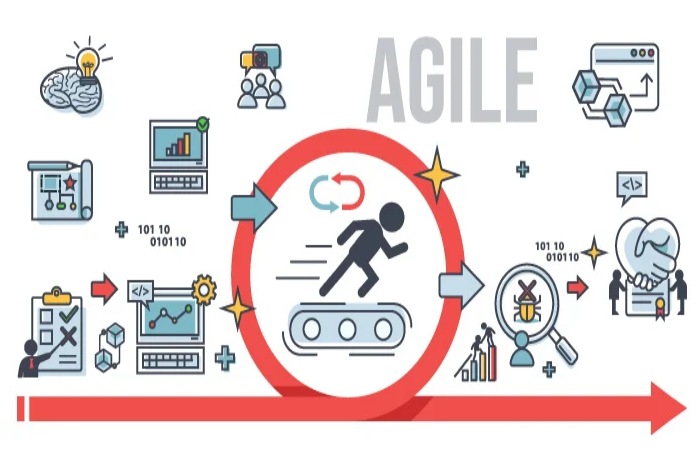Which Agile Approach Helps Teams Improve Their Project Cycle Time By Considering Team Capacity?: Agile development is one in which things are built in tiny, incremental portions, and genuine feedback is obtained as the story progresses. You may be considering using Agile methodology for your team’s next project. But how do you even begin? Scrum and Kanban are two of the most well-known variants of Agile. Both systems have pros and cons, but ultimately, they will assist your team members in obtaining the honest feedback they need to make better goods.
One Agile approach that helps teams improve their project cycle time by considering team capacity is Kanban. Kanban is a visual and iterative framework focusing on workflow management and continuous improvement. Scrum is an agile outline that helps teams develop products in short, time-boxed cycles known as “sprints.” It provides a structured tactic for project management and product development, emphasizing collaboration, flexibility, and iterative progress. Scrum consists of concepts, roles, events, and artifacts designed to facilitate the development of high-quality products.
Table of Contents
What is Agile?

Agile is an approach to creating software that emphasizes teamwork, dialogue, and suggestions—minimizing iterations and accelerating feature delivery aid teams in optimizing project cycle time.
Scrum and Kanban are two of the most popular forms of Agile methodology. Scrum is a methodology that calls for frequent meetings to review work, known as “sprints,” and the implementation of changes depending on the results of those discussions. Kanban teams have a similar strategy, except they utilize cards rather than boards to show their work. Both approaches stress the need to improve so that groups may grow from their experiences and advance more rapidly.
The effectiveness of an Agile approach hinges on how well it fits the culture of the team working on the project and how effectively it is adapted to those particulars. Agile may be the solution if you’re searching for a technique to shorten the time to complete a project without lowering quality or causing discord on the team.
The Agile Manifesto

The Agile Manifesto was first issued in 2001 and has become a foundational document for the Agile software development procedure. The manifesto states that large multi-year plans can be successfully executed by creating self-organized teams to drive rapid growth and deploy value for customers.
Many of the principles behind accelerated development were first introduced in military organizations, where they have proven successful in speeding up production times and improving quality. Agile methodology emphasizes collaboration, communication, and feedback among team members to ensure that everybody is alert to the project’s status and that requirements are constantly updated.
Agile methods can be used on large and small projects but are especially suitable for fast-paced environments where changes occur frequently. By adopting an elegant style, teams can reduce development cycles from months or years to weeks or days. It allows you to receive feedback more often and improve customer satisfaction.
How Does Agile Help Teams Improve their Project Cycle Time?
An agile approach can help teams improve their project cycle time by allowing them to:
- Address hazards early and frequently
- Get feedback fast
- Decrease cycle time through relationship and communication
- Improve quality through frequent testing
Advantages of Agile Project Management
Below, we list some of the advantages that agile project management offers us:

Product quality improvement: These methodologies encourage the proactive approach of team members in pursuing product excellence. Furthermore, the integration, testing, and continuous improvement of the product properties improve the final result.
Greater customer satisfaction: The customer is more satisfied by involvement and commitment throughout the development process. The client experiences the real-time improvements introduced in the process through various demonstrations and deliveries.
The greater motivation of workers: Self-managed work squads simplify the development of creative and innovation capacity among their members.
Collaborative work: The division of labor by different teams and roles and the growth of frequent meetings allow for better work organization.
Use of most relevant metrics: The metrics used to estimate limitations such as time, cost, performance, etc. They are usually more real in agile projects than in traditional ones. Thanks to the division into small teams and phases, we can be more aware of what is happening.
Greater control and predictability: The opportunity to review and adapt the product throughout the agile process allows all project members to exercise greater control over their work, improving predictability in time and costs.
Cost reduction: Agile project administration practically eliminates the likelihood of absolute failure in the project because errors are identified throughout development in its place for the future for the product to be over and all the investment made.
Business Collaboration
Collaborating with your clients helps the team to obtain critical information for the business as soon as possible (validate or discard hypotheses), thus allowing product development teams (whether software or not) to adjust and adapt their plans to this new reality. Snapshot.
The principles of this category are:
The development team should be open to changes in product requests even later in development. Agile methodologies take advantage of change to improve the client’s competitive advantage.
The product developers and the rest of the company’s value chain personnel must collaborate daily to fulfill the project.
Team Dynamics and Culture
The goal of these principles is to create an influential team culture that is inclusive, empowering, and mutually supportive.
The principles of these categories are:
Build projects around motivated and committed individuals. You have to give them the necessary work environment, meet their needs, and trust that they will do the right job.
- The most effective method of transmitting information between team members is through face-to-face conversations (or video calls, failing that) and not through asynchronous channels.
- Agile development provides and promotes sustainable organizational development over time.
- Autonomous teams provide the best products, mockups, plans, requirements, and designs.
The Most In-Demand Jobs in the Agile Sector
Agile coach: This person paves the way for workers to achieve the set objectives. If you are interested in learning more about this position, visit this article about the role of the Agile Coach.
Scrum Master: Top person responsible for the development of an agile Project. His functions include team leadership, controlling the quality of work, and organizing the different teams. You can find more information here about the duties of a scrum master.
Project Manager: This is not only for software development but for any discipline in which R&D is worked on, and extended projects that involve a multidisciplinary team are carried out.
Product Owner: One of the most critical roles in agile methodologies. Its primary function is to control all developments that affect a given product.
Conclusion
As businesses continue to grow and demand more invention, agility becomes increasingly essential to a company’s success. Skill can be defined as the ability of an association to respond and adapt rapidly to changes in its environment. Businesses must adopt different organizational models and processes supporting agile engagements to achieve agility. The three most normally adopted agile approaches are dangerous programming, scrum, and Kanban.
Also Read: xfinity.com Email

